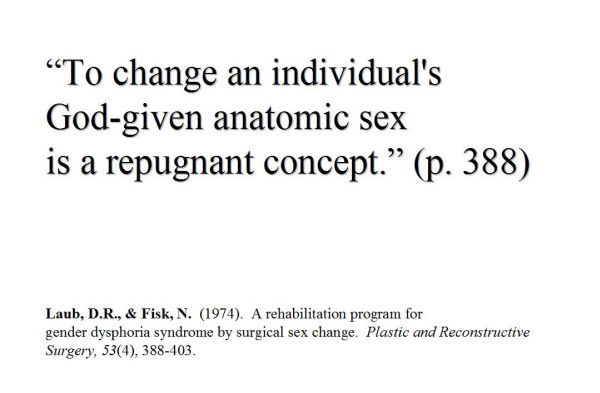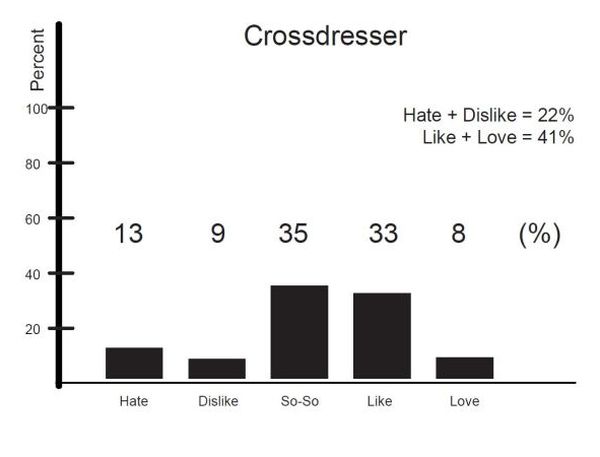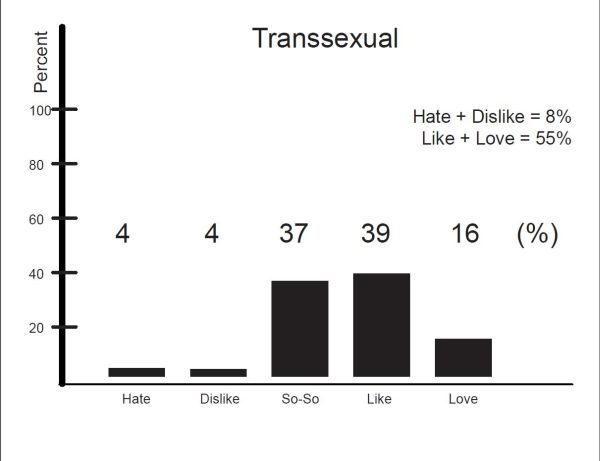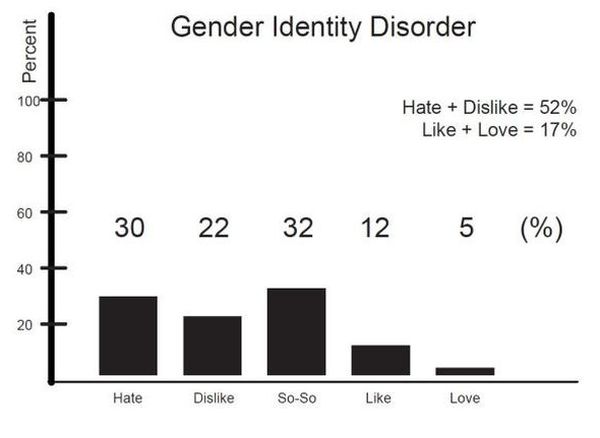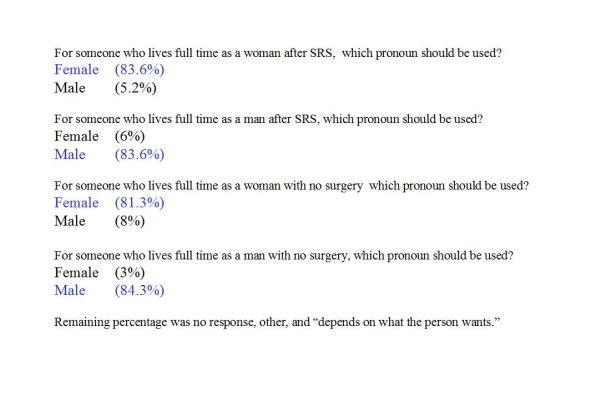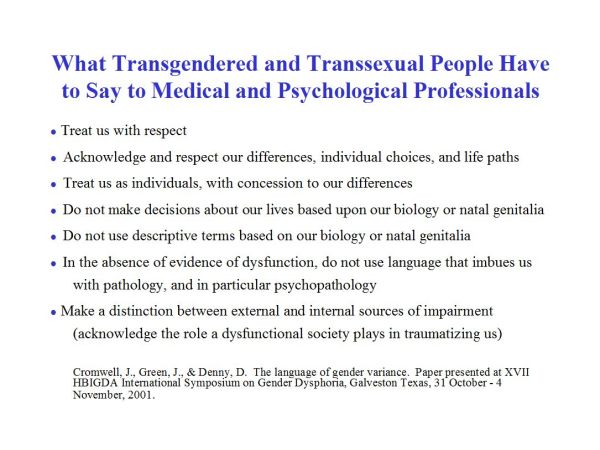The Language of Gender Variance (2001)

©2001, 2014 by Jason Cromwell, Jamison Green, & Dallas Denny
Source: Cromwell, Jason, Green, Jamison, & Denny, Dallas. (2001). The language of gender variance. Paper presented at the XXIV Harry Benjamin International Symposium on Gender Gender Dysphoria, Galveston, TX, 31 October – 3 November, 2001.
This paper presents data from a national survey of attitudes of transpeople about various and assorted terms which had been used to describe them. The survey was done in 1998.
Ten years later we again surveyed transpeople about their preference for terminology. The resulting paper is now under review for consideration for publication in the International Journal of Transgenderism. Please click the button below to see my brief post about our second survey.
View The Language of Gender Variance (2014)
The paper was read by Jamison Green. I was sitting with him. It includes discussion and slides that were omitted from the presentation due to constraints of time.
Introduction
Four years ago, at the HBIGDA conference in Vancouver, I read a paper co-authored with Dallas Denny, who was in the room. While presenting, I mentioned some terms commonly used by the medical and psychological community to refer to transgendered and transsexual people, and pointed out that many in the transgender community find them pejorative. After the talk, an eminently known and well-respected professional asked us, “What do you want us to call you?” Ms. Denny and I were at a loss for an answer, for we were unprepared to speak for the entire community.
And so, this paper was born. After we returned to our respective homes, we and Jason Cromwell devised a questionnaire to ask transgendered and transsexual persons their reactions to various and assorted terminology and usage—what they did and did not wish to be called. The questionnaire is available as a handout, if you should wish a copy.
Download Questionnaire (Word File)
In early 1998, we distributed the questionnaire via the internet and through mailings of FTM International and the American Educational Gender Information Service, Inc. 137 questionnaires were returned, of which 2 were incomplete and 1 was a duplicate, leaving 134 usable.
Demographics
Age of respondents varied from 15 to 71, with a mean of 39.5 years. 57 respondents (42.5%) indicated they had been assigned male at birth, and 66 (49.2%) female. 3 respondents (2.2%) indicated they were intersexed, and 7 (5.22%) did not respond to the question.
Question 5 asked respondents to choose which of 7 terms best described them. The terms most chosen were transsexual 67 (50%) and transgender(ist) 24 (17.9%). Other terms were androgyne, crossdresser, transsexed, intersexed, and nontranssexual/nontransgendered. With 67.9% of respondents indicating they were transsexual or transgendered, it’s clear our sample was comprised primarily of individuals with considerable gender variance.
Before we examine the data, I’d like to say a word or two about historic and emerging language usage, for we are seeing the emergence of terms originating within the transgender community which seem to be replacing terms which originated from the psychological and medical communities (Table 1).
- Transvestite, from the Latin, was coined around 1910 by Dr. Magnus Hirschfeld to refer to those who wore the clothing of the other sex. Since the 1950s, the transgender community has used the term crossdresser almost exclusively. The medical community still uses the diagnostic term transvestic fetishism, which 60% of our respondents either disliked or hated.
- Transsexual was used by D.O. Cauldwell in the late 1940s to refer to people who wish to “change their sex,” and was popularized by Harry Benjamin in the 1960s. Some in the community have come to spell the word with one s instead of two. The term transgender, used at first in community newsletters, came into widespread use in the early 1990s and is now in the name of this association’s on-line newsletter. Today, transgender is a widely-used term of self-definition by both transsexuals and nontranssexuals.
- Sex reassignment was used in the 1960s by the gender program at Johns Hopkins University. The transgender community has tended to use the term transition.
- Gender dysphoria, coined by Norman Fisk, came into use in the early 1970s, and was changed in the 1990s to Gender Identity Disorder. The transgender community tends to use terms which do not emphasize unhappiness or mental illness, for instance, gender variance.
- Male Transsexual has been used to refer to male-to-female transsexuals and Female Transsexual to refer to female-to-male transsexuals. Transsexuals tend to use terms like transsexual woman and FTM or Transman.
The issue at hand—and our reason for doing this study—is larger than a matter of language. We believe terminology goes hand in hand with particular viewpoints. When the field was in its early years, as terms like transvestite and gender dysphoria were being coined by the medical and psychological communities, the predominant viewpoint was that transgendered and transsexual people were unfortunates with some type of disorder or aberration. We believe some of the terms and usage which date from this period are inconsistent with a viewpoint of transgendered and transsexual people as healthy human beings, and we believe the usage which has evolved within the transgender community has been in part a reaction to medicalizing terminology—and we believe our data support this viewpoint. Viewed in retrospect, a great deal of the literature from the 1950s through the early 1990s can be seen as imbued with negative attitudes about transgendered and transsexual people.
For instance, a 1974 paper in The Journal of Plastic and Reconstructive Surgery began with this sentence: “To change an individual’s God-given anatomic sex is a repugnant concept.” This is a value-laden sentence perhaps unparalleled in the “objective” scientific literature (Figure 1).
Sometimes an author’s revulsion of transgendered and transsexual persons has been made manifest, as in a 1992 article in American Scholar, in which psychiatrist Paul McHugh cited “the confusions imposed on society where these [transsexual] men/women insist on acceptance” and the “sad caricature of the sexual reassigned” (pp. 503, 509, Figure 2).
More often, negative attitudes toward transgendered and transsexual people are subtle, and often amount to little more than a fashion critique, as in this passage from Steiner, 1990 (Figure 3):
Some biological males cross-dress in such a convincing manner, with discrete makeup and tasteful jewelry, that they “pass” as women without ever having commenced feminizing hormones. Others would pass if they were not so flamboyant! Strange esoteric hairdos and immensely long artificial nails like talons— usually painted a bright scarlet— may grossly exaggerate such patients’ appearance in a caricature of “femininity.” (p. 101).
These examples can be contrasted with writings from the 1990s which reflect a different and more positive view of gender variance—tending, for example, to acknowledge the role of society in its tolerance towards transgendered and transsexual people rather than heaping the blame solely upon them. We would like to point out that this new viewpoint has paved the way not only for great social acceptance and legal protections for transgendered and transsexual people, but to new scientific understandings as well—for instance, to Holly Devor’s multi-tiered analysis of FTM gender-variance, which replaced the “there is but one kind of FTM” dogma which had existed for more than 30 years.
And so, now to the data.
Results
You can see that respondents gave an amazing variety of responses to question No. 4, “What word or words would you use to describe yourself?” This finding is similar to Denny and Roberts’ 1995) survey of attitudes about the HBIGDA Standards of Care; the 339 respondents used more than 40 self-identity terms. We take this variety of terms as indicative of the complexity of language and conclude there is little chance we will soon be able to answer the question “What DO you want to be called?” (Table 2)
Here are some surprising results for the terms crossdresser and transvestite, further suggesting it will be difficult to obtain consensus from the community. We were surprised to find more than 1/5 of the respondents liked or loved the term transvestite and an equal percentage disliked or hated the term crossdresser (Figs. 4 & 5).
But look at the breakdown for the terms transsexual and FTM, which are clearly favorites (Figs. 6 & 7).
The term transgender is another clear favorite (Figure 8).
More than half of the respondents hated or disliked the term gender identity disorder, and only 17% liked or loved it. We’re not sure, but we suspect the fact that the diagnostic category holds some hope of medical coverage of transition-related expenses makes it more popular than it would otherwise have been (Figure 9).
When we look at questions about specific usage, the picture becomes clearer. You can see respondents overwhelmingly felt transsexuals should be referred to with pronouns appropriate for their presentation. This is true also for crossdressers, but the data are not so striking (Tables 3 & 4).
Respondents objected strongly to the use of quotation marks around proper names, pronouns, and body parts. We present just one slide to show representative data. We feel quotation marks, used in this manner, serve to deligitimize the individual, and clearly, respondents feel the same way. It should be noted these marks have been used widely in the literature, with psychoanalyst Leslie Lothstein being by far the worst offender.
Here’s a slide that summarizes much of our data (Figure 10):
Survey Conclusions
We have far more data than we have presented here, and our conclusions are not yet final. We feel that while we cannot yet say what transsexual and transgendered people wish to be called, we feel we can use our results to point out some things many transgendered and transsexual people consider offensive, to wit (TABLE 5):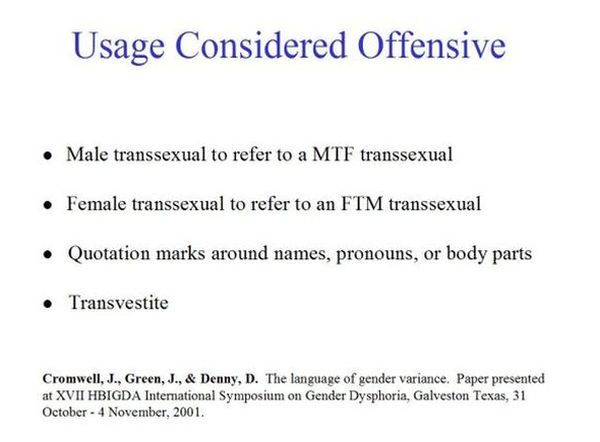
- Use of the term male transsexual to refer to those assigned male at birth (MTF transsexuals)
- Use of the term female transsexual to refer to those assigned female at birth (FTM transsexuals)
- Use of quotation marks around names, pronouns, or body parts
We suggest the terms male-to-female transsexual and female-to-male transsexual, respectively, or, better yet, transsexual woman and FTM or transman (TABLE 6).
Focus Groups
In September and October 2001, at the Southern Comfort and Fantasia Fair conferences, respectively, we conducted focus groups to discuss our project and ask what message(s) about language usage those in attendance would like professionals to hear. Seven principles came from the focus groups (TABLE 7):
What transgendered and transsexual people have to say to medical and psychological professionals:
- Treat us with respect
- Acknowledge and respect our differences, individual choices, and life paths
- Treat us as individuals, with concession to our differences
- Do not make decisions about our lives based upon our biology or natal genitalia
- Do not use descriptive terms based on our biology or natal genitalia
- In the absence of evidence of dysfunction, do not use language that imbues us with pathology, and in particular psychopathology
- Make a distinction between external and internal sources of impairment (acknowledge the role a dysfunctional society plays in traumatizing us)
Thank you.
References
Benjamin, H. (1966). The transsexual phenomenon: A scientific report on transsexualism and sex conversion in the human male and female. New York: Julian Press.
Cauldwell, D.O. (1949). Psychopathia transexualis. Sexology, 16, 274-280.
Denny, D., & Roberts, J. (1995). Results of a survey of consumer attitudes about the HBIGDA Standards of Care. Paper presented at the First International Congress on Gender, Cross Dressing, and Sex Issues, Van Nuys, CA, 23-26 February, 1995.
Devor, H. (1997). A social context for gender dysphoria. Paper presented at the XV Harry Benjamin International Gender Dysphoria Association Symposium: The State of Our Art and the State of Our Science, Vancouver, British Columbia, Canada, 10-13 September, 1997.
Fisk, N. (1973). Gender dysphoria syndrome (the how, what and why of a disease). In D. Laub & P. Gandy (Eds.), Proceedings of the Second Interdisciplinary Symposium on Gender Dysphoria Syndrome, pp. 7-14. Palo Alto, CA: Stanford University Medical Center.
Green, R., & Money, J. (Eds.). (1969). Transsexualism and sex reassignment. Baltimore: The Johns Hopkins University Press.
Hirschfeld, M. (1910). Die transvestiten: Eine untersuchung uber den erotischen verkleidungstrieh. Berlin: Medicinisher Verlag Alfred Pulvermacher & Co.
Laub, D.R., & Fisk, N. (1974). A rehabilitation program for gender dysphoria syndrome by surgical sex change. Plastic and Reconstructive Surgery, 53(4), 388-403.
Lothstein, L. (1983). Female-to-male transsexualism: Historical, clinical and theoretical issues. Boston: Routledge & Kegan Paul.
McHugh, P.R. (1992). Psychiatric misadventures. American Scholar, 61(4), 497-510.
Steiner, B.W. (1990). Intake assessment of gender-dysphoric patients. In R. Blanchard & B.W. Steiner (Eds.), Clinical management of gender identity disorder in children and adults, 93-106. Washington, D.C.: American Psychiatric Press.


